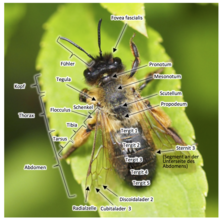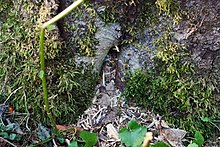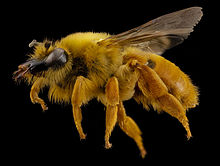Bees
| Bees | ||||||||||||
|---|---|---|---|---|---|---|---|---|---|---|---|---|

Wood bee ( Xylocopa violacea ) |
||||||||||||
| Systematics | ||||||||||||
|
||||||||||||
| Scientific name | ||||||||||||
| Apiformes | ||||||||||||
| Brothers , 1975 |
The bees (Apiformes or Anthophila) are a group of insects in which several families of the hymenoptera (Hymenoptera) are grouped together.
Colloquially, the term bee is usually reduced to a single species, the western honey bee ( Apis mellifera ), which receives special attention because of its importance as a honey producer that forms the state , but also because of its ability to defend itself. The bees are a fairly large group with very different species . Many of them, especially the solitary ones, are grouped under the term wild bees .
The scientific name of the bees is given differently depending on the author. Charles Michener prefers the name Apiformes in his standard work The Bees of the World . He succeeds the entomologist Denis J. Brothers. Numerous other authors call the bees Anthophila . This name, which was already in use in the 19th century, was reactivated by Michael S. Engel .
morphology
As a rule, bees are approx. 10 mm long, but the smallest are only 1.5 mm long, the largest bee, Megachile pluto, is the largest bee with a length of over 40 mm.
Bees have the insect-typical trisection of the body with four wings, the wasp waist like all Aculeata, and a defensive sting. Since this phylogenetically developed from the ovipositor, only females have a sting.
A special feature is the hairiness of the bees, whereby at least some hairs are always feathered. The back legs (leg collectors) or the underside of the abdomen (abdominal collectors) are often particularly hairy. The hair is often used to transport pollen. Pollen can stick to the branched hairs. By visiting several flowers, the bee contributes significantly to pollination. In cuckoo bees, the hair is often greatly reduced, but is almost always preserved on the Propodeum. The basitarsus of the hind legs is flattened in both males and females (in contrast to the digger wasps ). They usually have claws and adhesive rags on their feet.
The antennas are kneeled (ie the first antenna section is significantly longer than the following). The males have 13 antenna segments , the females 12 (except for Pasites and Biastes ). The mouthparts are reshaped into a trunk, but the mandibles (upper jaw) are bite organs.
Way of life
nutrition
Bees have a purely vegetarian diet. Your main food source is sweet vegetable juices - especially nectar . They are dependent on pollen for protein supply. Species of the state-forming genera and families, such as bumblebees , Meliponini and especially honey bees, create food supplies. This serves to survive as a whole colony in times without food, such as the rainy season ( tropics ) or a winter period in cooler climates.
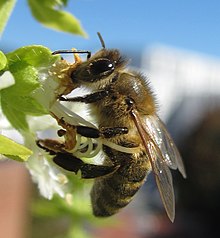
Polylectic bee species collect pollen as food for their broods of herbaceous species from different botanical families. In contrast to oligolectic species, they are ecological generalists.
Oligolectic bee species collect pollen as food for their brood exclusively from plant species in one family . Since, in contrast to polylectic species, they are unable to switch to other larval forage plants, they are locally threatened with extinction if their pollen donors disappear . The extreme form of oligolecty is monolecty.
As Monolektie the behavior of bees is called, collect the pollen as food for their brood exclusively of plant species of the same genus. Monolectic species are therefore completely dependent on the occurrence of their species-specific larval forage plants for reproduction.
Bees, whose females collect oil in flowers, either as food for the larvae or for themselves or for building nests, represent a specialty. The genera Macropis and Ctenoplectra are known for this .
Social associations and states


Highly social community forms, especially states like the honey bee , are the exception among the bee species. Such communities focus almost exclusively on the cup collectors within the Apidae family, namely on Apis with 9 species, Bombus with around 250 and Meliponini ( stingless bees ) with around 370 species.
The overwhelming majority of all bee species are solitary bees (approx. 75%) and cuckoo bees (approx. 15%), which do not form insect states, but live alone and only care for their own offspring . In solitary bees, the egg is deposited together with a supply of food and the depository is tightly closed. Cuckoo bees are breeding parasites that lay their eggs in the brood cells of other bees where they kill the larvae and feed on the food supply. This behavior is commonly known as social parasitism . About 10% of the bees are social.
There is a whole range of intermediate forms between the solitary way of life and the formation of states :
- Common defensive behavior in larger clusters of bees, which otherwise live in independent neighborhood side by side. For example, swarm attacks on humans have been observed in the willow sand bee ( Andrena vaga ) and the common fur bee ( Anthophora plumipes ) who came into the flight range of a colony.
- Hibernating communities in communal caves or plant hollows.
- Male bees sleeping communities in spring. These sleeping communities are usually found together in exposed places, especially at the tips of plant stems. The biological meaning of these communities is still unclear, as the animals find in them neither food nor protection from enemies, cold or wind.
- Nistgemeinschaften common nest inputs . Within the nesting community, each female occupies her own cell in which she lays her own egg. If there is a crowd at the entrance, the females take each other into consideration.
- Guard services at the entrance to the nesting communities.
- Cooperation in the creation and provision of the cells.
- Division of labor in reproduction: only some of the females lay eggs, the others take care of nest building, provisions and guard duty.
- Brood care by feeding the larvae and removing their droppings.
- Further specialization in reproduction. With the furrow bee Laxioglossum pauxillum, for example, the overwintered female builds a nest tunnel with up to 25 cells in which she lays her eggs. The offspring do not reproduce, but expand the nest and look after the other offspring of their mother. It is not until late summer that the drones , as the males are called by the colonizing bees and wasps , and larger, reproductive females are born. The mother dies and the mated young women establish new colonies next spring . This reproduction and brood care behavior comes very close to the conditions in a bee colony.
Such more or less pronounced forms of social community were observed in the genus Euglossa as well as within the families of the Halictidae , Anthophoridae , Megachilidae and Andrenidae .
Ecology, economy
Since bees make a significant contribution to the conservation of wild and cultivated plants and their yields, their ecological importance is considerable; Bees are among the most important pollinators in the world . According to the environmental protection organization Greenpeace , the equivalent of their annual pollination work is around 265 billion dollars worldwide. Its related economic importance is also evident from the fact that in Germany, for example, around one million bee colonies are currently kept by over 80,000 beekeepers . With around 25,000 tons of honey per year, these cover around 20% of domestic needs.
For a number of years, increasing so-called " bee deaths " have been observed. As a measure of beekeeping, the term does not refer to the death of individual bees, but to the colony losses of the honeybees. The buzzword hides very different phenomena: for example the disappearance of entire bee colonies in the middle of the season, especially in the USA (“ Colony Collapse Disorder ”), or unusually high winter losses (for example in Germany in winter 2002/2003).
In mid-December 2017, the General Assembly of the United Nations , meeting in New York , declared May 20th, on a proposal from Slovenia with the support of all EU countries, to be “ World Day of Bees ”: This should “raise awareness of the importance of bees and others through education and activities Pollinate increasing the dangers to which they are exposed and their contribution to sustainable development ”.
Systematics and evolution
The number of bee species is estimated at around 20,250 worldwide. Of these, around 700 species are native to Europe, around 500 of them in Germany . Particularly species-rich genera are Lasioglossum , Andrena and Megachile , each with more than 1,500 species. The bees with a defensive sting belong to the stinging voices .
Development history
Today's bees are on flowering plants, the angiosperms (angiosperms), instructed in the Earth's history in the early Cretaceous appeared and since the late Cretaceous, the gymnosperms and Pteridophyte repressed. Flowering plants from around 110 million years ago already have characteristics that suggest pollination by bees, so the origin of the bees is probably before the middle of the Cretaceous period. These plants may have been widespread earlier, but cannot be detected due to the lower amounts of pollen produced.
Today's most pristine flowering plants are pollinated by beetles, so it seems reasonable to assume that they were also the pollinators of the first Cretaceous flowering plants. In the further course of the tribal history, however, bees and flowering plants developed collectively and supported each other: By carrying the pollen from plant to plant, bees improved their chances of reproduction . The plants began to adapt and developed sweet juices to bind the animals to themselves. Over time, both bees and flowering plants adapted to each other better and better (co-evolution): the plants developed their current flower shapes with deep nectar calyxes and stamens, the bees developed their long proboscis in order to get close to the nectar and specially adapted to it coat adapted to pollen transport.
It is uncertain whether bees originally fed on pollen from wind-pollinated plants, but it has been suspected several times.
The oldest fossil bee is known as Cretotrigona prisca and was found - embedded in amber - in the American state of New Jersey . The find is dated to an age of approximately 75 to 92 million years. It is noteworthy that the animal can be incorporated into a tribe (Meliponini), which only contains state-forming species, which suggests a very early split of the corresponding subgroup. Originally it was even described in a genus that was still alive.
Tribal forerunners of the bees are likely to have resembled today's digger wasps . Digger wasps provide their brood with a food supply by paralyzing a prey animal with a sting and then burying it together with their egg or eggs. This breeding behavior is similar to that of today's solitary bees , with the difference that the latter do not use prey, but pollen as a food supply for their offspring. It can be assumed that the bees are a sister group of a subgroup of the Crabronidae (Ammoplanina).
Phylogenetic systematics
The monophyletic status of bees is proven by numerous common derived characteristics (synapomorphies) and is considered undisputed. The close relationship between bees and digger wasps is also undisputed . For a long time, both groups were viewed as sister groups, until the digger wasps were recognized as paraphyletic . A summary of digger wasps in a family (Sphecidae) or a superfamily (Sphecoidea), which is compared to the bees in the form of the superfamily Apoidea, shows the actual systematic conditions only unsatisfactorily. It would be more appropriate to include the bees as the only family among several families of digger wasps.
On the other hand, the distinction between several families has long been established within the bees. This appears to be justified by clear differences in body structure and is the basis for further subdivisions on lower taxonomic levels. A compromise proposed by the group's leading systematists summarizes the families of digger wasps and bees in two series (Spheciformes and Apiformes) under the superfamily Apoidea .
Families of bees

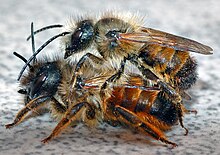
The division of the bees into several families is based, among other things, on the structure of the mouthparts, an important feature is the distinction between short- and long-tongued bees. According to Plant & Paulus (2006), bees are divided into the following families and subfamilies:
Clade I: Short-tongued bees
- Halictidae : about 4,400 species, almost 80 genera, subfamilies: Halictinae, Nomioidinae, Nomiinae, Rophitinae (= Dufoureinae); Genera in Central Europe (after): Furrow bees ( Halictus and Lasioglossum ), spiral horn bees , Dufourea , Rhophitoides , Rophites , Nomia , Nomioides , Sphecodes
- Andrenidae : almost 3,000 species, 46 genera, subfamilies: Andreninae, Panurginae, Oxaeinae (partly considered as a separate family); Species in Central Europe, Andrena , panurgus , Camptopoeum , Panurginus , Melitturga
- Stenotritidae : 21 species, 2 genera, restricted to Australia (some are included in the Colletidae)
- Colletidae : approx. 2,500 species, 90 genera, mostly goiter collectors , subfamilies: Diphaglossinae, Colletinae; Represented in Central Europe by the silk bees and mask bees
Clade II (Melittidae + long-tongued bees)
- Melittidae : about 200 species, 14 genera, subfamilies: Dasipodainae, Melittinae, Meganomiinae; They were considered "short-tongued", but are the sister group of (Megachilidae + Apidae). in Central Europe: trouser bees , thigh bees and sawhorn bees
Long-tongued bees:
- Megachilidae : approx. 2,135 species, 76 genera, subfamilies: Pararhophitinae, Fideliinae, Lithurginae, Megachilinae; Belly collector , in Central Europe the genera Osmia , Hoplitis , Hoplosmia ( mason bees ), Anthidium , Lithurgus , Stelis , Dioxys , Megachile , Coelioxys , Chelostoma , Heriades
-
Apidae : approx. 6,035 species, 172 genera, subfamilies: Nomadinae, Xylocopinae, Apinae ; very different forms, in Central Europe the following tribes and genera:
- Tribus Nomadini : Ammobates , Pasites , Ammobatoides , Biastes , Epeolus, Triepeolus and Nomada
- Tribe Xylocopini : Wood bees ( Xylocopa ) and Ceratina
- Tribus Apini : Epeoloides , Eucera , Tetralonia , Anthophora , Melecta , Thyreus , bumblebees , cuckoo bumblebees and honey bees ( Apis ). In the Neotropic z. B. Meliponini (with Melipona and Trigona, among others ) and Euglossini ( Euglossa , Eulaema , Eufriesea , Exaerete and Aglae ).
In older works, the Apidae family is often limited to the basket collectors and all other groups split off as the Anthophoridae family . Because of the paraphyletic status of the Anthophoridae, this view is considered outdated. The cup collectors , traditionally regarded as a closed group (Apinae), consist of the following tribe :
- Apini
- Honey bees ( Apis ): 9 species, of which only the western honey bee is native to Central Europe
- Bombini
- Bumblebees ( bombus )
- Meliponini : Stingless bees (23 genera), occur in all tropical regions, especially in Central and South America with a large number of species
- Euglossini : 5 genera
The thorn
The bees' poison sting is a defensive sting . In the course of evolution, it was formed from an egg laying apparatus. Consequently, only the females, i.e. queens and workers, always have a sting. This applies to all casting voices . So males cannot sting in principle.
The plant wasps use the stinger to pierce plants for egg-laying; in the case of the legumes , such as the parasitic wasps , the egg is deposited in the body of a host animal. In the case of the stinging voices, the function of the sting changed; it is used to administer poison in order to paralyze prey animals that serve as larval food. After all, in the bees, which mainly supply their larvae with pollen, the sting has a purely defensive function. The defense of the state is of particular importance with regard to the state-building bees, the honey bees and the bumblebees . Since the sting of the honey bees is equipped with barbs, it stops at random in the elastic skin of humans and other warm-blooded animals stuck and the bee dies. The amount of poison injected with a sting is given as 0.1 mg.
With most wild bees, the sting is only used if the bee feels individually threatened, e.g. B. when pressed between fingers. Most of the time, when stings from wild bees, the pain is not very severe and therefore harmless. Only if you are allergic, which is very rare in wild bees, is there a real danger. In mask bees and sand bees , the sting is so weak that it cannot penetrate human skin. In the tropics there are stingless bees ( Meliponini ) that can fight back with bites and secretions.
politics
"Save the bees" is a referendum in Bavaria that aims to promote biodiversity and prevent insect death. 18.4% of the Bavarians entitled to vote have signed it. The catalog of measures contains drastic changes. In Brandenburg, two competing popular initiatives on the topic were launched, one in December 2019, one in February 2020, one of the initiatives is more likely to be supported by the environmental associations, the second, less strict by the land users. However, in March 2020 the Brandenburg state parliament declared one of the initiatives to be inadmissible. The Federal Environment Ministry also wants to pass a Germany-wide insect protection law.
literature
- May Berenbaum : bloodsucker, founder of the state, silk manufacturer. The ambivalent relationship between humans and insects. Spektrum Akademischer Verlag, Heidelberg 1997, ISBN 3-8274-0078-3 .
- Guido Fackler , Michaela Fenske , Franziska Gleichauf (eds.): From the honeycomb into the world: the bee makes culture. (= Catalog of the exhibition of the same name in Lab 13 at the Landesgartenschau Würzburg 2018 / Writings and materials of the Würzburg Museology, issue 6). Julius Maximilians University of Würzburg, Würzburg 2018, ISSN 2197-4667 ( PDF ).
- Jutta Gay, Inga Menkhoff: The big book of bees. Fackelträger-Verlag, Cologne 2012, ISBN 978-3-7716-4495-6 .
- Dave Goulson : The rarest bees in the world. A travel report. Hanser Verlag, Munich 2017, ISBN 978-3-446-25503-6 .
- Randolf Menzel , Matthias Eckoldt : The intelligence of bees. How they think, plan, feel and what we can learn from them. Knaus, Munich 2016, ISBN 978-3-8135-0665-5 .
- Charles Duncan Michener : The Bees of the World. The Johns Hopkins University Press, Baltimore 2000 (2nd edition 2007), ISBN 0-8018-6133-0 (English).
- Andreas Müller, Albert Krebs, Félix Amiet: Bees: Central European species, way of life, observation. Naturbuch-Verlag, Munich 1997, ISBN 3-89440-241-5 .
- Thomas Dyer Seeley : Bee Democracy. How bees decide collectively and what we can learn from them. Fischer Taschenbuch-Verlag, Frankfurt am Main 2015, ISBN 978-3-596-19407-0 .
- Erwin Scheuchl, Wolfgang Willner: Pocket dictionary of wild bees in Central Europe. All species in portrait. Quelle & Meyer Verl. Wiebelsheim, 2016, ISBN 978-3-494-01653-5 .
- Karl Weiß: Bees and bee colonies. CH Beck, Munich 1997, ISBN 3-406-41867-8 .
- Paul Westrich : Germany's wild bees. E. Ulmer Verlag Stuttgart, 2018, ISBN 978-3-8186-0123-2
- Noah Wilson-Rich (Ed.): The bee. History, biology, species. Haupt, Bern 2015, ISBN 978-3-258-07869-4 .
Web links
- Bees - Information from the Federal Food Safety and Veterinary Office
- Hymenoptera Information System : Hymenoptera families worldwide (checklists, taxonomy and nomenclature, red lists, current literature, photo gallery, etc.)
- naturbildarchiv-guenter.de : Photos of the species and behavior of numerous wild bee species occurring in Germany
- Wildbienen.de : biology, species, protection
- Recordings from the collection of the Austrian Federal Institute for Scientific Film (ÖWF) in the online archive of the Austrian Media Library
Individual evidence
- ↑ Denis J. Brothers: Phylogeny and classification of the aculeate Hymenoptera, with special reference to Mutillidae. In: University of Kansas Science Bulletin. Volume 50, 1975, pp. 483-648.
- ↑ David Grimaldi, Michael Engel: Evolution of the Insects. Cambridge University Press, 2005, ISBN 978-0-521-82149-0 . P. 454.
- ↑ E. Königsmann: Insects 2 . In: rororo animal world . tape 11 . Rowohlt, 1971, ISBN 3-499-28011-6 , pp. 366 ff .
- ↑ Insecta . In: HH Dathe (ed.): Textbook of Special Zoology . 2nd Edition. I, 5th part. Spektrum Akademischer Verl., 2003, ISBN 3-8274-0930-6 , pp. 649 .
- ↑ (PDF) Oil flowers and oil-collecting bees. Retrieved March 12, 2019 .
- ↑ a b c d e f g John D. Plant, Hannes F. Paulus : Evolution and Phylogeny of Bees. January 11, 2016, accessed March 12, 2019 .
- ↑ Alina Reichardt, Johannes Kaufmann: The bee becomes a federal matter. In: Hamburger Abendblatt. June 8, 2016, p. 22
- ↑ Karafyllis, NC / Friedmann, G. 2017: No honey licking: bees as 'ecosystem service providers' and natural environment. In: Natural Philosophy. A text and study book. Tübingen, UTB / Mohr Siebeck: 292–302, here: 295
- ↑ http://www.deutschland-summt.de/bienensterben.html
- ↑ UN introduces World Bee Day - EURACTIV.de. Retrieved December 24, 2017 .
- ^ Charles D. Michener, David A. Grimaldi: A Trigona from Late Cretaceous Amber of New Jersey (Hymenoptera: Apidae: Meliponinae). In: American Museum Novitates. Volume 2917, 1988. pp. 1-10.
- ↑ Michael S. Engel: A New Interpretation of the Oldest Fossil Bee (Hymenoptera: Apidae). In: American Museum Novitates. Volume 3296, 2000. pp. 1-11.
- ↑ Manuela Sann, Oliver Niehuis, Ralph S. Peters, Christoph Mayer, Alexey Kozlov: Phylogenomic analysis of Apoidea sheds new light on the sister group of bees . In: BMC Evolutionary Biology . tape 18 , no. December 1 , 2018, ISSN 1471-2148 , doi : 10.1186 / s12862-018-1155-8 , PMID 29776336 ( biomedcentral.com [accessed March 12, 2019]).
- ↑ Müller, Andreas., Krebs, Albert., Amiet, Felix .: Bees: Central European genera, way of life, observation . Natur-Buch-Verl, Augsburg 1997, ISBN 3-89440-241-5 .
- ↑ http://www.aktion-wespenschutz.de/Wektiven%20Sie/Stich/Stich.HTM
- ^ P. Westrich: The wild bees of Germany . Ulmer Verl., Stuttgart 2018, ISBN 978-3-8186-0123-2 , pp. 88 .
- ^ Lisa Schnell, Christian Sebald: The most successful Bavarian referendum of all time . In: sueddeutsche.de . February 15, 2019, ISSN 0174-4917 ( sueddeutsche.de [accessed on March 22, 2019]).
- ↑ Overview of popular initiatives carried out in Brandenburg as of May 19, 2020
- ↑ Thorsten Gellner: Where to sign? Insect lovers should know that Article, Märkische Allgemeine Zeitung, April 19, 2019.
- ↑ Popular initiative “Save biodiversity - secure the future!” Appeals to the state constitutional court . Press release from April 6, 2020.
